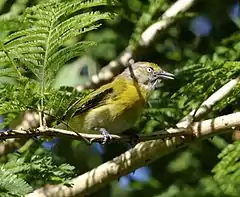| Hylophilus[1] | |||
| Temminck, 1822[2] | |||
 Przedstawiciel rodzaju – leśniak żółtopierśny (H. thoracicus) | |||
| Systematyka | |||
| Domena | |||
|---|---|---|---|
| Królestwo | |||
| Typ | |||
| Podtyp | |||
| Gromada | |||
| Podgromada | |||
| Infragromada | |||
| Rząd | |||
| Podrząd | |||
| Rodzina | |||
| Podrodzina | |||
| Rodzaj |
Hylophilus | ||
| Typ nomenklatoryczny | |||
|
Hylophilus poicilotis Temminck, 1822 | |||
| Synonimy | |||
|
| |||
| Gatunki | |||
| |||
Hylophilus – rodzaj ptaków z podrodziny wireonków (Vireoninae) w obrębie rodziny wireonkowatych (Vireonidae).
Występowanie
Rodzaj obejmuje gatunki występujące w Ameryce Środkowej i Południowej[6].
Morfologia
Długość ciała 11,4–13 cm; masa ciała 8–14 g[7].
Systematyka
Etymologia
Podział systematyczny
Do rodzaju należą następujące gatunki[9]:
- Hylophilus amaurocephalus (von Nordmann, 1835) – leśniak brazylijski
- Hylophilus poicilotis Temminck, 1822 – leśniak rdzawołbisty
- Hylophilus flavipes Lafresnaye, 1845 – leśniak ubogi
- Hylophilus semicinereus P.L. Sclater & Salvin, 1867 – leśniak szaroszyi
- Hylophilus brunneiceps P.L. Sclater, 1866 – leśniak brązowogłowy
- Hylophilus thoracicus Temminck, 1822 – leśniak żółtopierśny
- Hylophilus olivaceus von Tschudi, 1844 – leśniak oliwkowy
- Hylophilus pectoralis P.L. Sclater, 1866 – leśniak siwogłowy
Uwagi
- ↑ Wariant pisowni Hylophilus Temminck, 1822.
- ↑ Nomen nudum; synonimia niepewna[4].
Przypisy
- ↑ Hylophilus, [w:] Integrated Taxonomic Information System (ang.).
- ↑ C.J. Temminck: Nouveau recueil de planches coloriées d’oiseaux: pour servir de suite et de complément aux planches enluminées de Buffon, édition in-folio et in-4º de l’Imprimerie royale, 1770. Cz. 3. Strasbourgh: Chez Legras Imbert et Comp., 1838, s. pl. 173. (fr.).
- ↑ S. Müller. Aanteekeningen, over de natuurlijke gesteldheid van een gedeelte der westkust en binnenlanden van Sumatra; met bijvoeging van eenige waarnemingen en beschrijvingen van verscheidene, op dit, en andere Sunda – eilanden voorkomende dieren. „Tijdschrift voor natuurlijke geschiedenis en physiologie”. 2, s. 334, 1835. (niderl.).
- 1 2 The Key to Scientific Names ↓, Thaumasioptera [dostęp 2023-06-09].
- ↑ Ch.L. Bonaparte. Notes sur les collections rapportées en 1853, par M. A. Delattre, de son voyage en Californie et dans le Nicaragua. „Comptes Rendus Hebdomadaires des Séances de l’Académie des Sciences”. 38, s. 389, 1854. (fr.).
- ↑ „F. Gill, D. Donsker & P. Rasmussen (redaktorzy)”: Shrikes, vireos, shrike-babblers. IOC World Bird List (v13.1). [dostęp 2023-06-09]. (ang.).
- ↑ D.W. Winkler, S.M. Billerman & I.J. Lovette, Vireos, Shrike-Babblers, and Erpornis (Vireonidae), version 1.0, [w:] S.M. Billerman, B.K. Keeney, P.G. Rodewald & T.S. Schulenberg (redaktorzy), Birds of the World, Cornell Lab of Ornithology, Ithaca, NY 2021, , DOI: 10.2173/bow.vireon1.01 [dostęp 2023-06-09] (ang.).

- ↑ The Key to Scientific Names ↓, Hylophilus [dostęp 2022-10-11].
- ↑ Systematyka i nazwy polskie za: P. Mielczarek & M. Kuziemko, Podrodzina: Vireoninae Swainson, 1837 – wireonki (wersja: 2022-09-11), [w:] Kompletna lista ptaków świata [online], Instytut Nauk o Środowisku Uniwersytetu Jagiellońskiego [dostęp 2023-06-09].
Bibliografia
- The Key to Scientific Names, J.A. Jobling (red.), [w:] Birds of the World, S.M. Billerman et al. (red.), Cornell Lab of Ornithology, Ithaca (ang.).
This article is issued from Wikipedia. The text is licensed under Creative Commons - Attribution - Sharealike. Additional terms may apply for the media files.